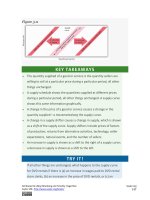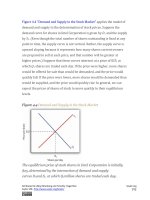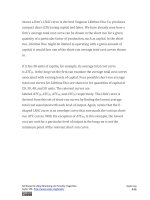Authors libby rittenberg 155
Bạn đang xem bản rút gọn của tài liệu. Xem và tải ngay bản đầy đủ của tài liệu tại đây (557.58 KB, 1 trang )
there is a surplus of 20 million pounds of coffee per month. Given a
surplus, the price will fall quickly toward the equilibrium level of $6.
A surplus in the market for coffee will not last long. With unsold coffee on
the market, sellers will begin to reduce their prices to clear out unsold
coffee. As the price of coffee begins to fall, the quantity of coffee supplied
begins to decline. At the same time, the quantity of coffee demanded begins
to rise. Remember that the reduction in quantity supplied is a
movement along the supply curve—the curve itself does not shift in
response to a reduction in price. Similarly, the increase in quantity
demanded is a movement along the demand curve—the demand curve
does not shift in response to a reduction in price. Price will continue to fall
until it reaches its equilibrium level, at which the demand and supply
curves intersect. At that point, there will be no tendency for price to fall
further. In general, surpluses in the marketplace are short-lived. The prices
of most goods and services adjust quickly, eliminating the surplus. Later
on, we will discuss some markets in which adjustment of price to
equilibrium may occur only very slowly or not at all.
Shortages
Just as a price above the equilibrium price will cause a surplus, a price
below equilibrium will cause a shortage. A shortage is the amount by
which the quantity demanded exceeds the quantity supplied at the current
price.
Figure 3.16 "A Shortage in the Market for Coffee" shows a shortage in the
market for coffee. Suppose the price is $4 per pound. At that price, 15
million pounds of coffee would be supplied per month, and 35 million
Attributed to Libby Rittenberg and Timothy Tregarthen
Saylor URL: />
Saylor.org
155









